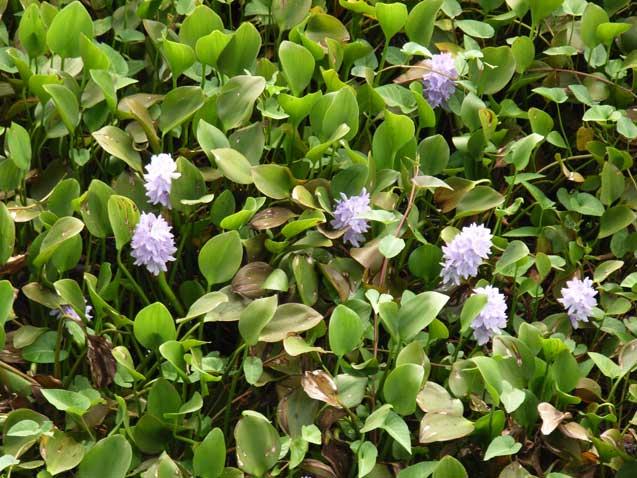Eichhornia crassipes

|
|
Pontederia crassipes Common Names: Water Hyacinth, Floating Water Hyacinth,
Common Water Hyacinth Scientific
Classification Kingdom: Plantae Clade: Tracheophytes Clade: Angiosperms Clade: Monocots Clade: Commelinids Order: Commelinales Family: Pontederiaceae Genus: Pontederia Species: P. crassipes Binomial Name: Pontederia crassipes Mart. Synonyms: Eichhornia crassipes (Mart.) Solms, Eichhornia cordifolia Gand., Eichhornia crassicaulis Schltdl., Eichhornia speciosa Kunth, Heteranthera formosa Miq., Piaropus crassipes (Mart.) Raf., Piaropus mesomelas Raf., Pontederia crassicaulis Schltdl., Pontederia elongata Balf. Morphological Description Pontederia crassipes, widely known as water hyacinth, is a free-floating aquatic
perennial with a robust structure. Key features include: · Roots: Feathery, fibrous, black to purple, up to 1 m long, aiding
nutrient absorption · Leaves: Broad, glossy, ovate to rounded, 10–20 cm wide, with
bulbous, spongy petioles (10–30 cm long) for buoyancy · Flowers: Lavender to pink, 4–6 cm wide, 6 petals with a yellow spot
on the upper petal, in spikes of 8–15, blooming year-round in warm climates · Fruit: Capsules, 1–1.5 cm, containing up to 300 seeds, rarely
viable in invaded regions Its rapid vegetative
reproduction via stolons drives its invasiveness (Pellegrini et al., 2018). Distribution and Habitat Pontederia crassipes is native to the Amazon basin, thriving in: · Native Range: Brazil, Peru, Bolivia · Introduced Range: Southern U.S., Southeast Asia (India,
Vietnam), Africa (Nigeria, Kenya, South Africa), Australia · Habitat: Lakes, ponds, slow rivers, canals, prefers nutrient-rich,
still/slow-moving waters · Climate: Tropical/subtropical, 20–35°C, tolerates pH 4–10 · Elevation: Sea level to 2,000 m It has invaded over 50
countries, often outcompeting native flora (Fern, 2023). Ethnopharmacology Pontederia crassipes, formerly known as Eichhornia crassipes and
commonly referred to as water hyacinth, is a fast-growing aquatic plant found
in tropical and subtropical regions. While often considered an invasive species
due to its rapid spread in water bodies, it has notable medicinal properties
rooted in both traditional use and scientific studies. The plant contains
flavonoids, alkaloids, phenolic compounds, saponins, and tannins, which
contribute to its antioxidant, antimicrobial, anti-inflammatory, analgesic, and
antidiabetic activities. Traditionally, water hyacinth has been used to treat
skin diseases, gastrointestinal issues, wounds, and infections. Extracts from
the leaves and roots have shown antibacterial and antifungal effects against
pathogens like E. coli, Staphylococcus aureus, and Candida albicans. Its
antioxidant properties help neutralize free radicals, suggesting potential in
preventing oxidative stress-related diseases. Some studies also indicate
hepatoprotective and neuroprotective benefits.Despite its medicinal potential,
caution is needed due to the plant’s ability to accumulate heavy metals and
toxins from polluted water sources. Therefore, any medicinal use should ensure
that the plant is harvested from clean environments, and further toxicological
and pharmacological research is essential for safe therapeutic application. · Wounds/Boils: Leaf poultices in Nigeria heal sores; enhances fibroblast
activity (40% at 50 µg/mL) (Ben Bakrim et al., 2022). · Dysentery: Eichhornia crassipes (water hyacinth) exhibits antibacterial
activity, with extracts showing inhibition against various bacteria like
Escherichia coli, Bacillus subtilis, Staphylococcus aureus, and Pseudomonas
aeruginosa (Haggag et al., 2017). · Goiter: Plant juice in Bangladesh taken orally for treatment of
goiter. · Antioxidant Cytotoxic Activity: Leaf extract can reduces oxidative stress;
The leaf extract exhibited the strongest ABTS
cation radical scavenging activity, with an IC50 value of 42.91 ± 5.42 µg/mL.
Its high tannin content (2.823 ± 0.139 mg TAE/g extract) is believed to
contribute to its antioxidant properties. Additionally, the leaf extract
demonstrated the most potent cytotoxic activity against MCF-7 cells, with an
IC50 value of 38.27 ± 19.17 µg/mL. (IC₅₀ 35 µg/mL) (Willy et al., 2023). · Anti-inflammatory: Eichhornia crassipes exhibits notable
anti-inflammatory and anti-arthritic effects in an animal model of FCA-induced
rheumatoid arthritis (RA). Treatment with E. crassipes led to a reduction in
arthritis progression, paw edema, and histopathological changes. Its
therapeutic effects may be linked to the suppression of inflammatory markers
such as TNF-α, IL-1β, IL-6, NF-ĸB, MMP-2, MMP-3, and VEGF. Additionally, E.
crassipes lowered PGE2 levels. The effects of E. crassipes flowers in
alleviating RA were also found to be comparable to those of piroxicam (Sattar
et al., 2023).
⚠ Toxicity Profile: Accumulates heavy metals (lead, mercury) and
toxins from polluted water; unsafe as fodder or medicine if contaminated. LD₅₀
> 2,000 mg/kg in rats (safe orally), but caution in pregnancy or prolonged
use (Ben Bakrim et al., 2022). Additional Information · Environmental Impact: Forms dense mats, reducing oxygen (below 5
mg/L), blocking sunlight, and disrupting fisheries (Villamagna & Murphy,
2010). · Control Measures: Biological (weevils Neochetina), mechanical harvest, herbicides (glyphosate)
(Fern, 2023). · Uses: Phytoremediation (removes arsenic, 80% at 10 mg/L), biogas
(1 kg yields 200 L methane), crafts (baskets, mats) (Ben Bakrim et al., 2022). · Nutrition: 20% protein, 40% carbs as fodder; rich in carotene (PROTA,
2019). References
External Links More Pictures |
|
| Compounds of Eichhornia crassipes | |
| References |